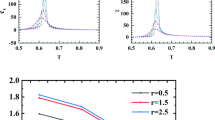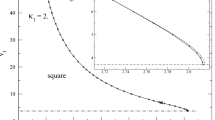Abstract
This article offers a detailed analysis of interacting particles in the two-dimensional square array, which is a coarse-graining model to study the multiple occupancy lattice gas system. The equilibrium properties with the maximum loading number 2 is obtained in this work. We find the large nearest neighbor interaction leads to the steeper isotherms and the large on-site interaction leads to the plateaus isotherms. The phase transitions are discussed, and the phase diagrams are obtained via the Monte Carlo simulations. By analyzing finite size effect and the hysteresis behavior, the phase boundaries and the tricritical points are located in the phase diagrams. Our results reveal the complex equilibrium phase transitions in the double occupancy lattice gas.
Graphic abstract
This article utilizes the double occupancy lattice gas to study the interacting particles in the two-dimensional square array. The equilibrium properties with the maximum loading number 2 is obtained in this work. The large nearest neighbor interaction leads to the steeper isotherms and the large on-site interaction leads to the plateaus isotherms. The phase diagram is obtained via the Monte Carlo simulations. By analyzing finite size effect and the hysteresis behavior, the phase boundaries and the tricritical points are located in the phase diagram.









Similar content being viewed by others
Data Availability Statement
This manuscript has no associated data or the data will not be deposited. [Authors’ comment: This article is theoretical and has no associated experimental data, and all numerical data are included in the figures of Sect. 3.]
References
M.E. Davis, Ordered porous materials for emerging applications. Nature 417, 813 (2002)
L.D. Gelb, K.E. Gubbins, R. Radhakrishnan, M. Sliwinska-Bartkowiak, Phase separation in confined systems. Rep. Prog. Phys. 62, 1573 (1999)
F.G. Pazzona, P. Demontis, G.B. Suffritti, A grand-canonical Monte Carlo study of the adsorption properties of argon confined in ZIF-8: local thermodynamic modeling. J. Phys. Chem. C 117, 349 (2012)
C. Tunca, D.M. Ford, A hierarchical approach to the molecular modeling of diffusion and adsorption at nonzero loading in microporous materials. Chem. Eng. Sci. 58, 3373 (2003)
D.W. Siderius, V.K. Shen, Use of the grand canonical transition-matrix Monte Carlo method to model gas adsorption in porous materials. J. Phys. Chem. C 117, 5861 (2013)
E. Beerdsen, D. Dubbeldam, B. Smit, Understanding diffusion in nanoporous materials. Phys. Rev. Lett. 96, 044501 (2006)
R. Krishna, Diffusion in porous crystalline materials. Chem. Soc. Rev. 41, 3099 (2012)
T. Becker, K. Nelissen, B. Cleuren, B. Partoens, C. Van den Broeck, Diffusion of interacting particles in discrete geometries. Phys. Rev. Lett. 111, 110601 (2013)
P. Demonitis, F.G. Pazzona, G.B. Suffritti, A lattice-gas cellular automaton to model diffusion in restricted geometries. J. Phys. Chem. B 110, 13554 (2006)
K. Binder, W. Kinzel, D.P. Landau, Theoretical aspects of order-disorder transitions in adsorbed layers. Surf. Sci. 117, 232 (1982)
D.P. Landau, Critical and multicritical behavior in a triangular-lattice-gas Ising model: repulsive nearest-neighbor and attractive next-nearest-neighbor coupling. Phys. Rev. B 27, 5604 (1983)
K. Binder, D.P. Landau, Square lattice gases with two-and three-body interactions: a model for the adsorption of hydrogen on Pd (100). Surf. Sci. 108, 503 (1981)
J.-Q. Yin, D.P. Landau, Square lattice gases with two- and three-body interactions revisited: a row-shifted 2*2 phase. Phys. Rev. E 81, 031121 (2010)
Y. He, R.B. Pandey, Driven diffusion, Kawasaki dynamics, mixing, and spatial ordering in an interacting lattice gas. Phys. Rev. Lett. 71, 565 (1993)
R. Finken, J.-P. Hansen, A.A. Louis, Phase separation of a multiple occupancy lattice gas. J. Phys. A Math. Gen. 37, 577 (2004)
A.J. Archer, A.M. Rucklidge, E. Knobloch, Soft-core particles freezing to form a quasicrystal and a crystal-liquid phase. Phys. Rev. E 92, 012324 (2015)
D. Frydel, Y. Levin, Soft-particle lattice gas in one dimension: one-and two-component cases. Phys. Rev. E 98, 062123 (2018)
T. Becker, K. Nelissen, B. Cleuren, B. Partoens, C. Van den Broeck, Diffusion of interacting particles in discrete geometries: equilibrium and dynamical properties. Phys. Rev. E 90, 052139 (2014)
M. Blume, Theory of the first-order magnetic phase change in \(UO_2\). Phys. Rev. 141, 517 (1966)
H.W. Capel, On the possibility of first-order phase transitions in Ising systems of triplet ions with zero-field splitting. Physica 32, 966 (1966)
H.W. Capel, On the possibility of first-order phase transitions in Ising systems of triplet ions with zero-field splitting II. Physica 33, 295 (1967)
H.W. Capel, On the possibility of first-order phase transitions in Ising systems of triplet ions with zero-field splitting III. Physica 37, 423 (1967)
A.K. Jain, D.P. Landau, Monte Carlo study of the fcc Blume-Capel model. Phys. Rev. B 22, 445 (1980)
N.B. Wilding, P. Nielaba, Tricritical universality in a two-dimensional spin fluid. Phys. Rev. E 53, 926 (1996)
D.P. Lara, J.A. Plascak, The critical behavior of the general spin Blume–Capel model. Int. J. Mod. Phys. B 12, 2045 (1998)
J.C. Xavier, F.C. Alcaraz, D. Pena Lara, J.A. Plascak, Critical behavior of the spin-1 Blume-Capel model in two dimensions. Phys. Rev. E 57, 11575 (1998)
W. Kwak, J. Jeong, J. Lee, D.-H. Kim, First-order phase transition and tricritical scaling behavior of the Blume-Capel model: a Wang-Landau sampling approach. Phys. Rev. E 92, 022134 (2015)
N. Metropolis, A.W. Rosenbluth, M.N. Rosenbluth, A.H. Teller, E. Teller, Equation of state calculations by fast computing machines. J. Chem. Phys. 21, 1087 (1953)
D.P. Landau, K. Binder, A Guide to Monte Carlo Simulations in Statistical Physics, 3rd edn. (Cambridge University Press, Cambridge, 2009)
R.B. Griffiths, Thermodynamics near the two-fluid critical mixing point in He3-He4. Phys. Rev. Lett. 24, 715 (1970)
Acknowledgements
Wei Liu would like to thank Prof. David P. Landau for his valuable discussion.
Author information
Authors and Affiliations
Corresponding author
Additional information
This work is supported by the National Natural Science Foundation of China under Grant nos. 11405127 and 11805151.
Rights and permissions
About this article
Cite this article
Liu, W., Yan, Z. & Zhou, G. Phase transitions of a double occupancy lattice gas. Eur. Phys. J. B 94, 133 (2021). https://doi.org/10.1140/epjb/s10051-021-00142-7
Received:
Accepted:
Published:
DOI: https://doi.org/10.1140/epjb/s10051-021-00142-7




